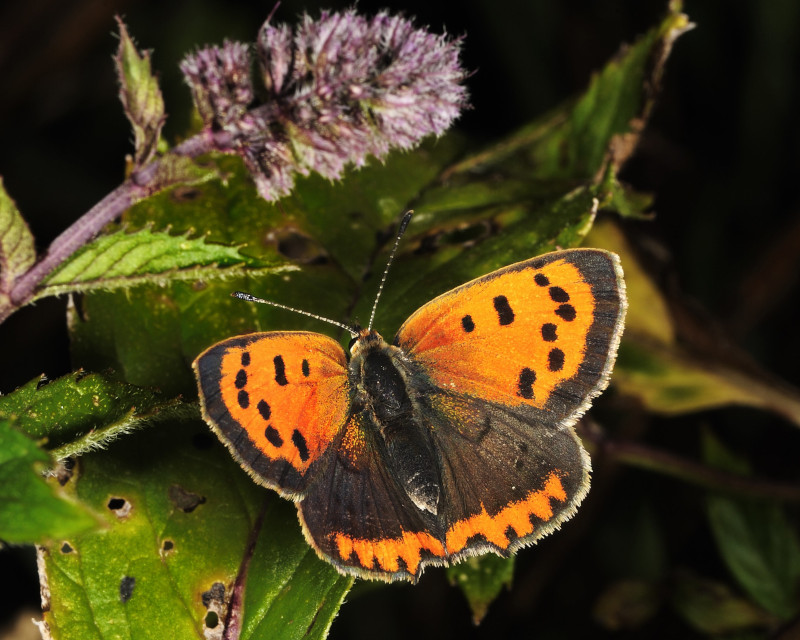Small Copper Facts
- This lovely small creation of Nature and evolution is most frequently referred to by the descriptive common name of the Small Copper. It does have a few other, generally used titles, though. Those include the terms common copper and American copper.
- Within scientific circles, though, the Lepidoptera’s more often called by its technical title. That moniker, however, although short, remains rather difficult for the layperson to pronounce. That’s because it holds the official name of the Lycaena phlaeas.
- It received that specific name due to the efforts of the esteemed Swedish zoologist, Carl Linnaeus. The researcher accomplished the first formal recognition of it as a separate and distinct species. That scientifically noteworthy event occured in the year 1761.
- Intriguingly, entomologists consider the beautiful creature to have around 2 dozen subpscies! Some controversy surrounds this belief, though, among their peers. Many of these are under consideration for elevation to the status of separate species.
- Thankfully, the delicate Small Copper seems to be maintaining a sufficient and stable population base. That fortunate situation further appears to hold true throughout its entire range. The IUCN, therefore, presently has no listing for in on the Red List.
- Nevertheless, the tiny marvel faces the same potential threats to its existence as most species do. Like those other creatures, most of these stem from the actions of humans. They include such perils as habitat loss, and, of course, ongoing climate change.
Related Articles
Small Copper Physical Description
The gorgeous Small Copper qualifies as a true delight to encounter. It makes a pleasant sight in its surroundings, and impresses the viewer for different reasons. Sheer size isn’t among those, though. That’s true since, as the name suggests, it’s a small butterfly.
It also follows the pattern common to many of its relatives regarding physical description. That’s the fact that it displays a degree of the physiological characteristic of sexual dimorphism. In its case, this trait manifests itself in terms of pure physical dimensions.
More precisely, females of the species attain a greater average wingspan than their male counterparts. That disparity remains minor, however. Females reach an average wing width of 0.6 in (1.5 cm). The wings of the males, meanwhile average approximately 0.52 in (1.3 cm).
Otherwise, individuals of both genders present the same basic pattern of appearance. The upper side of the forewing shows an orange background, with black spots. It also has a dark outer marging. But the underside shows a paler orange with black spots and a small band.
The hindwings of the beautiful Small Copper show a different pattern, however. This consists of a grayish upperside, accompanied by an orange border and a row of black spots. The underside, though, presents as powder white with an orange band and black spots.
- Kingdom: Animalia
- Phylum: Arthropoda
- Class: Insecta
- Order: Lepidoptera
- Family: Lycaenidae
- Genus: Lycaena
- Species: L. phlaeas
Small Copper Distribution, Habitat, and Ecology
The marvel known best as the Small Copper evolved as native to a surprisingly wide expanse of the globe. That exact zone of habitation, however, remains very specific. That’s because it developed as endemic to certain parts of Asia, Europe, northern Africa, and North America.
Within that greater area, though, it only appears in the more northerly sections. In North America, that range includes the northern and central parts of Canada and the United States. In Europe and Asia, it also appears in most of the northern sections of the continents.
Nature provided this wonder with an advantage in its habitat preferences. That’s true since it displays a fairly strong acceptance of multiple habitat types. It does, however, need a temperate climate. It also shows a surprising fondness for disturbed areas to call home.
This includes a wide range of ecosystems. The invertebrate appears in such diverse locations as grassland, savanna, mountainous regions, and even warmer parts of the tundra. It also often inhabits such sites as open fields, meadows, urban parks, and even back yards.
Mating period for the Small Copper extends from early spring through autumn. Females lay a single egg in multiple locations, such as stones, plants, even wooden boards. Adults feed on the nectar of a wide variety of locally available plants, and live for up to one year.
Species Sharing Its Range
Check out our other articles on 5 Woefully Rare Woody Shrubs, Eastern Gray Squirrel, Cumberland Falls, Wolf Eel, Appalachian Avens, Alligator Snapping Turtle, Orange Jewelweed, Pea Blue

